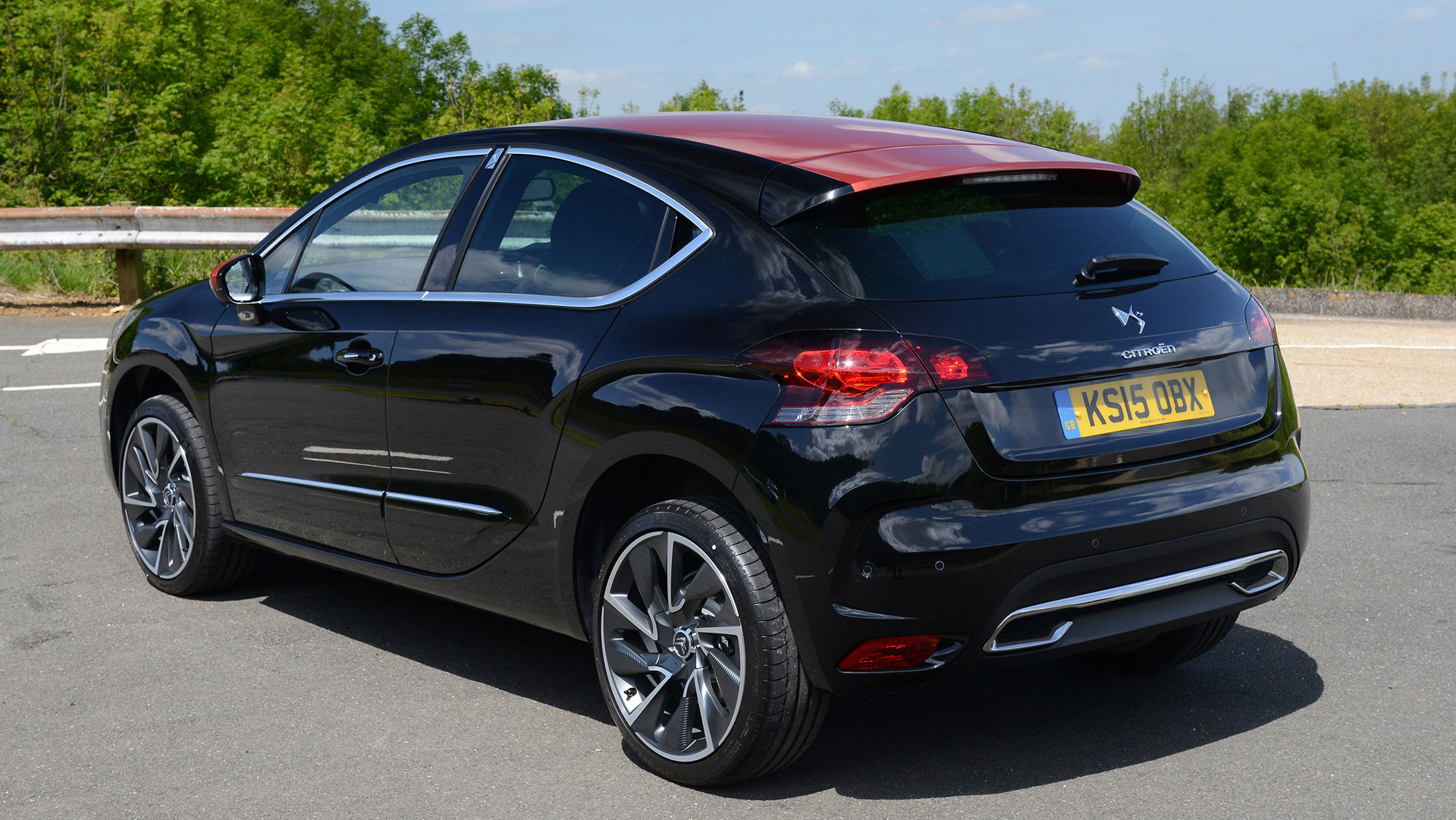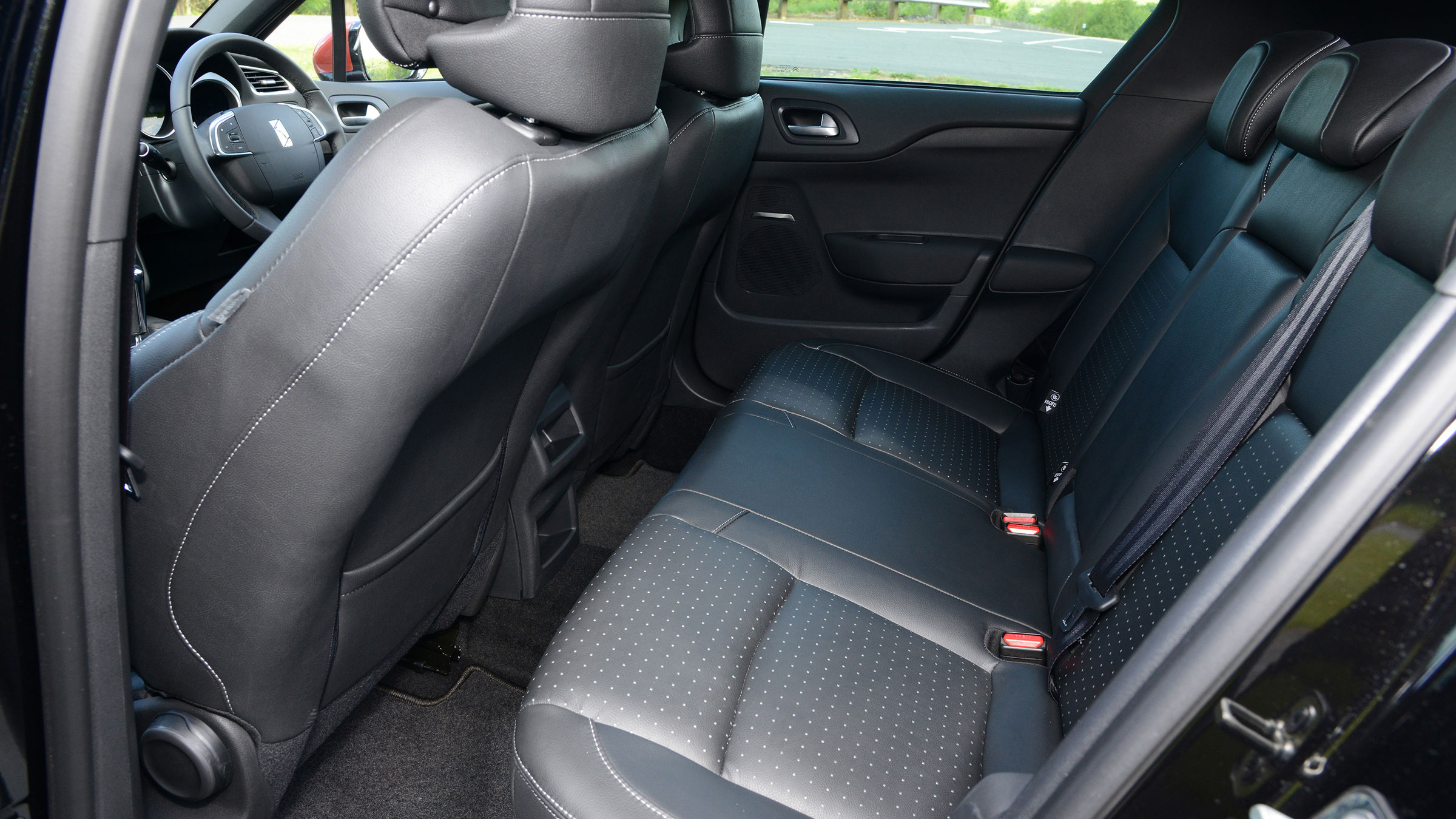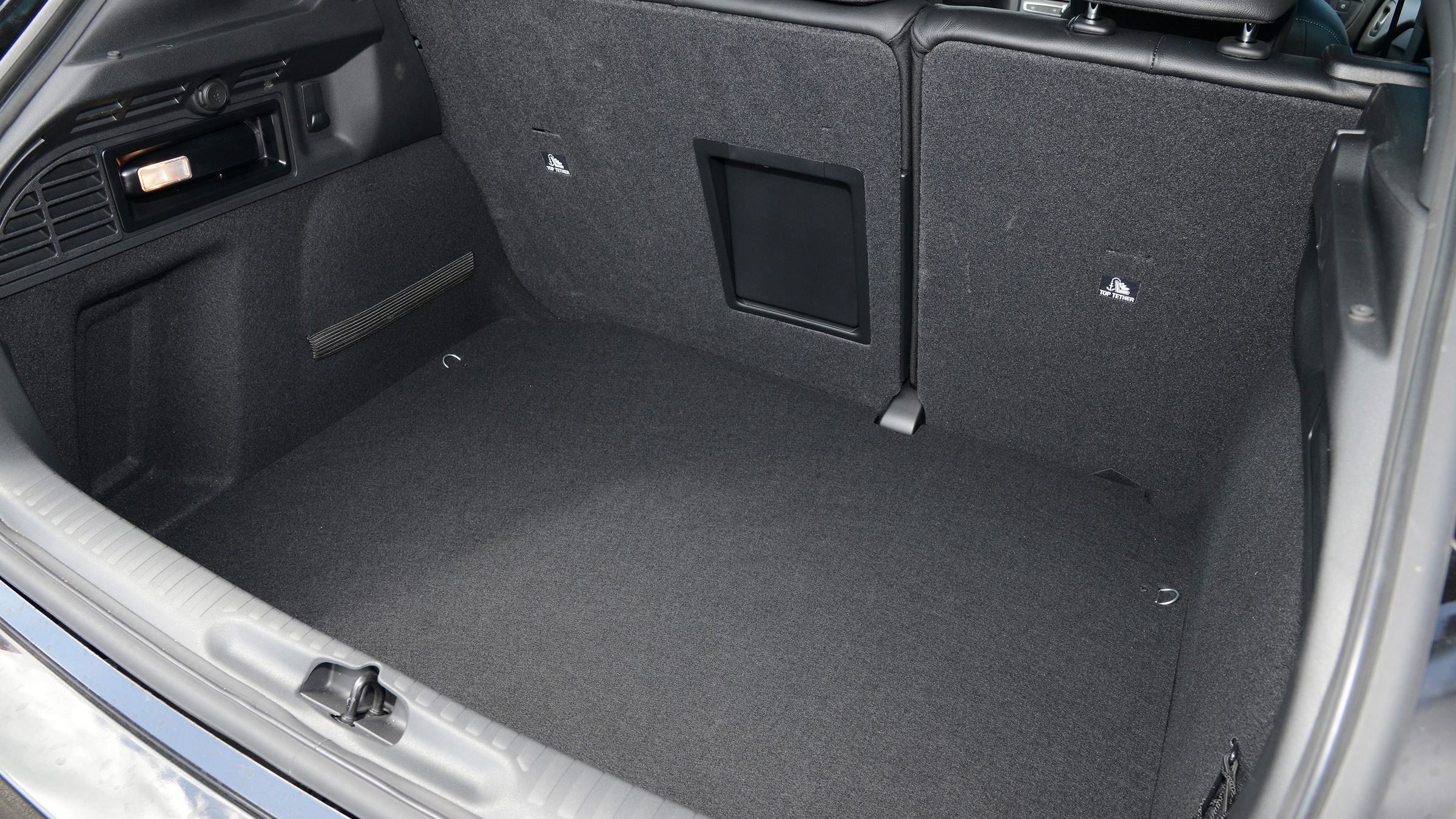DS4 (2012-2018) Review
Quirky looking DS 4 has a certain charm and is well-equipped, but lacklustre driving experience and limited safety kit show its age.
Strengths & weaknesses
- Eye-catching styling
- Well-equipped
- Frugal engines
- Rear windows don’t open
- Firm ride
- Poor residuals
Originally launched as a Citroen, the DS 4 is a family hatchback aiming to mix coupe styling with premium finish and desirability. Pinning rivals down for the car is tricky as it doesn’t fall easily into a category, but the Alfa Romeo Giulietta, BMW 1 Series and more expensive VW Golf models are all potential alternatives.
Whatever the competition there’s no denying the DS 4 is a bold looking machine. It's distinctive, and the bold curves and shapes help hide its size. Facelifted cars get a very prominent chrome grille treatment. However, there are downsides to the rakish styling, not least the fact that windows for the rear doors do not open. Yes, really.
Once you’ve got over this shock you’ll have time to take in the interior, which makes a decent fist of delivering some upmarket appeal. Some of the plastics look and feel cheap, but there are soft-touch materials used higher up in the cabin (the dashboard and door tops), while the ‘watch strap’ leather trim fitted to later cars has a real wow factor, particularly in the lighter colours.
Less impressive is the DS 4’s practicality. Not only can you not open those rear windows, the space for rear seat passengers is more cramped than in a VW Golf. And while the 385-litre boot is class competitive it’s worth bearing in mind that this figure shrinks to 359-litres if you specify the Denon hi-fi, which takes up valuable underfloor space with a subwoofer speaker.
There’s better news up front, where the driver and passenger sit a little higher than in most family hatchbacks - those in the higher riding Crossback variant are placed a little higher again.
There’s a decent range of seat and wheel adjustment, while the major entertainment and heating controls are handily placed on a centre console that’s angled towards the driver. Less impressive are the dated looking dials complete with a trip computer that has the sort of blocky graphics that would shame a cheap digital watch.
Early cars also suffered from a poor entertainment system that was both slow to respond and hobbled by old-fashioned graphics. Happily matters improved markedly on the post-2015 cars, which got the latest 7-inch touchscreen. It still trails the best systems, but the inclusion of Apple CarPlay and MirrorLink mean a seamless connection to your smartphone.
Parent firm Citroen has been pushing safety for years now, so it’s no surprise to find the DS 4 gets a five-star Euro NCAP rating. All cars get six airbags, electronic stability control and a speed limiter.
However, the car’s age means that it misses out on cutting edge safety kit. There’s no autonomous emergency braking, adaptive cruise control or lane keep assist. Blind spot monitoring is standard on the latest cars and has been optional since new - so it’s worth keeping an eye for cars fitted with this.
Sadly it’s not just the safety kit that’s a bit old hat - the driving experience feels dated too. While it’s luxuriously appointed the cabin is noisier at speed than you’d expect, with a little more wind and road noise than newer models. It also doesn’t ride as softly and comfortably as you’d expect of a car wearing the DS badge. The trade-off for the slightly raised ride height being a firm ride that can crash and thud alarmingly into potholes.
It’s not a lot of fun to steer through corners either. There’s decent grip, but the power assisted steering is slow and you get disconcerting kickback through your hands and arms when the car hits a mid-corner bump. The other controls are fairly lacklustre too, with an indistinct gearshift and brakes that have an uncomfortably sharp action.
Key facts
| Warranty | 3 years / 60,000 miles |
|---|---|
| Boot size | 359 - 385-litres |
| Width | 1810mm |
| Length | 4284mm |
| Height | 1497-1535mm |
| Tax (min to max) | £20 - £260 |
Best DS DS 4 for...
Best for Economy – DS 4 BlueHDi 120 S&S
Smooth, punchy and frugal 1.6-litre diesel is capable of up to 74.3mpg, provided it’s fitted with the smaller 17-inch wheels - larger wheels reduce efficiency
Best for Families – DS 4 PureTech 130 S&S
The refined and eager 1.2-litre petrol delivers enough performance and is as well-suited to the school run as it is longer haul trips. Kids won’t enjoy the DS 4’s fixed rear windows, though.
Best for Performance – DS 4 THP 210
Packs 1.6-litre turbo from Peugeot 208 GTi engine for rapid 7.8 seconds 0-62 mph sprint.
One to Avoid – DS 4 Crossback Terre Rouge BlueHDi 180 EAT6
Mix of coupe styling and rugged off-roader looks is a bit odd, while the big diesel engine is surprisingly thirsty and offers little real-world performance gain over smaller unit.
History
Oct 2010: Citroen DS 4 launched at Paris Motor Show
Jun 2011: First UK cars go on sale with choice of 1.6-litre and 2.0-litre diesels, plus naturally aspirated and turbocharged 1.6-litre petrols
Aug 2015: Citroen name is dropped and standard DS 4 is joined by rugged Crossback version with raised ride height. New 1.2-litre petrol replaces entry-level 1.6-litre
Apr 2017: 210 THP petrol and HDi 150 diesel engines are dropped from the range. Trim lines are also revised, with adoption of Performance line for the DS 4 and Terre Rouge and Moondust for the DS 4 Crossback
May 2018: DS 4 and DS 4 production ended
Understanding DS DS 4 names
Model Crossback
The DS 4 was available either as a standard five-door hatchback or a rugged-looking Crossback. The latter featured raised suspension as some tough plastic body cladding
Trim Terre Rouge
DS chopped and changed the trims, with early Citroen models available in DSign, DStyle and DSport guises. Facelift cars were originally known as Elegance, Prestige and Crossback, before DS 4 models were given Elegance, Performance Line and Prestige tags. You could also choose the Crossback in standard, Terre Rouge and Moondust trims
Engine Blue HDi 180 S&S
Also diesel models were known as BlueHDi, while the number related to the power output in PS. PureTech are the petrols, apart from the most powerful 1.6-litre, which was a Turbo High Performance, or THP. S&S referred to the stop-start system that stops the engine when stationary and automatically restarts it before you pull away.
Gearbox EAT6
Most cars came with a six-speed manual as standard, but those badged EAT6 automatic. Early cars were also available with the EGS6 set-up, which was essentially an automated manual gearbox
DS DS 4 Engines
Petrol: VTi 120, PureTech 130, THP 160, THP 165, THP 200, THP 210
Diesel: HDi 110, e-HDi 110, BlueHDi 120, BlueHDi 150, HDi 160, BlueHDi 180
Despite a relative short life the DS 4 has been fitted with more than its fair share of engines. However, look past the baffling acronyms and seemingly random numbers and you’ll discover there’s essentially five engines - two petrols three petrols and two diesels. Over time these have been tweaked for improved performance and efficiency, but the underlying units have stayed the same.
Kicking off the petrol line-up is the 1.6-litre VTi 120. Available in the DS 4 when it was badged a Citroen, this four-cylinder unit is smooth and refined enough, but struggles to cope with the car’s near 1,400kg kerbweight. Factor in a few passengers and the odd incline and the VTi can become breathless.
After the car’s facelift in 2015 this engine was replaced by the PureTech 130. Although smaller at 1.2-litres and featuring only three-cylinders, it was fitted with turbocharger that helped raise power to 130hp. With a smooth and thrummy soundtrack and plenty of torque low down in the rev range it suits the easy-going nature of the DS 4. It’s frugal too, promising nearly 60mpg.
Buyers looking for more performance could choose from the range of THP (Turbo High Performance) engines. All were based on the same 1.6-litre four-cylinder, which in the early Citroen model was available in 158hp and 197hp guises. By the time the facelift DS 4 arrived in 2015 these outputs had been increased to 163hp and 207hp respectively. In both instances the lower powered versions were only available with a six-speed automatic, while the high-powered cars were exclusively six-speed manuals.
The THP is a good unit, with plenty of get-up-and-go from low down in the rev range and surprisingly rorty sound when worked hard. Yet it’s quiet when you’re taking it easy and, in the case of the later machines, surprisingly frugal. Unless you need an auto (the later EAT6 is much smoother than the older unit), then the THP 210 delivers all the pace you’ll need.
Of the diesel engines it’s the 1.6-litre that’s the pick of the bunch. It’s an impressively refined unit on the move, with only slight diesel clatter when idling. The Citroen-badged version delivered 108hp and clearly feels more sluggish than the later BlueHDi (this is DS’s term for diesels fitted with its most efficiency enhancing features) version, which in the real world feels almost as spritely as the larger 2.0-litre, yet returns over 70mpg.
Early cars were available with the EGS6 automatic gearbox, which is best avoided. Essentially an automated version of the six-speed manual it serves-up slow and uncomfortably jerky shifts. The more traditional EAT6 automatic used in the later cars is far smoother and a lot more efficient.
At the top of the diesel tree is the 2.0-litre, which packed 158hp in the Citroen DS4. It’s not quite as smooth as the smaller engine, while efficiency isn’t as strong as you’d expect. Matters improved with the later BlueHDi version, which managed to be over 10mpg more efficient and faster from 0-62mph despite a lower power output. Both get a six-speed manual gearbox, which as in all DS 4 models lacks the precision and robust feel of Ford Focus’ shift.
You could specify a six-speed automatic with this engine, which resulted in a power hike to 177hp. Yet while that figure looks impressive on paper it’s barely any quicker than the 148hp model and in regular motoring, it’s not particularly fuel efficient.
|
Fuel |
Fuel economy |
Power |
Acceleration (0-62mph) |
Top speed |
|
|
VTi 120 |
Petrol |
45.6mpg |
118hp |
12.1sec |
120mph |
|
PureTech 130 |
Petrol |
56.5 - 57.6mpg |
128hp |
9.9sec |
123mph |
|
THP 160 |
Petrol |
36.7mpg |
158hp |
9.3sec |
132mph |
|
THP 165 EAT6 |
Petrol |
50.4mpg |
163hp |
8.7sec |
131mph |
|
THP 200 |
Petrol |
44.1mpg |
197hp |
8.5sec |
146mph |
|
THP 210 |
Petrol |
47.9mpg |
207hp |
7.8sec |
146mph |
|
HDi 110 |
Diesel |
60.1mpg |
108hp |
12.4sec |
118mph |
|
e-HDi 110 |
Diesel |
64.2mpg |
108hp |
12.4sec |
118mph |
|
BlueHDi 120 |
Diesel |
68.9 - 74.3mpg |
118hp |
10.9 - 11.4sec |
117 - 120mph |
|
BlueHDi 150 |
Diesel |
67.3 - 68.9mpg |
148hp |
8.8sec |
129mph |
|
HDi 160 |
Diesel |
55.4mpg |
158hp |
9.3sec |
132mph |
|
BlueHDi 180 EAT6 |
Diesel |
64.2mpg |
177hp |
8.6sec |
127 - 132mph |
DS DS 4 Trims
DSign, DStyle, DSport, Elegance, Performance Line, Prestige, Crossback, Crossback Terre Rouge, Crossback Moondust
At the launch of the Citroen DS4 there were just three trim levels, each catchily incorporating DS in its title.
DSign was the entry level and only available with the lowest powered petrol and diesel engine. All the essentials were included on this model, such as air-conditioning, cruise control, alloy wheels and remote central locking. However, items such as Bluetooth, parking sensors and climate control were optional extras.
Stepping up to the DStyle brought many of these desirable additions as standard, plus powerfold mirrors and more comfortable sports front seats. Auto wipers and headlamps are added, as are family friendly additions like map pockets in the backs of the front seats and a handy drawer hidden under the driver’s seat.
Splashing out on the DSport meant being limited to either the THP200 petrol or HDi 160 diesel, but it did mean even more standard kit. On top the DStyle’s impressive tally you were treated to heated and leather trimmed seats, blind spot monitoring and 19-inch alloy wheels. Finally, Citroen’s e-Touch system was added, which could automatically call the emergency services in the event of an accident.
In terms of options, Citroen bundled most into decent value packs. So for the DSign you could have the Automatic Signature pac (climate control and auto lights and wipers) and the City Signature pack (parking sensors and power fold door mirrors). On the DStyle the Security Signature pack (blind spot and tyre pressure monitoring) was desirable, while both it and the DSport could be had with the Security Xenon Signature, which added directional xenon headlamps and high-pressure washers.
Following the rebranding of DS as a standalone brand in 2015 the DS 4 range was overhauled, with line-up trimmed to Elegance and Prestige, while the high-riding Crossback arrived as a standalone model.
More importantly, equipment levels became more generous, with the entry-level Elegance now getting dual zone climate control and a touchscreen entertainment system that included sat-nav and Apple CarPlay. It also gained all the neat practical touches from the old DStyle, but with the addition of a boot courtesy light that doubled as a removable and rechargeable torch.
The Prestige benefitted from all these upgrades, plus it got leather seat trim, keyless entry and a reversing camera. On the outside it was identified by its 18-inch alloy wheels and standard xenon headlamps.
For the Crossback you got a raised ride height and some chunky plastic cladding for the wheelarches, plus a smattering of Crossback logos. In terms of standard equipment it got the same kit as the Elegance.
At the same time the options list was reduced in size, with most extras being available to bring the Elegance and Crossback up to the standard of the Prestige. However, all versions could be ordered with the Denon hi-fi upgrade, while the Prestige and Crossback could be specified with the eye-catching ‘watchstrap’ leather seat trim. Externally there was the option to a contrasting roof colour, if that was your thing.
In 2017 the DS 4 line-up was refreshed slightly with the arrival of Performance Line, Crossback Terre Rouge and Crossback Moondust models. Fitting into the existing line-up they added either extra sportiness or luxury depending on the version.
The Performance Line was based on the Elegance and essentially was no more than a cosmetic exercise; with little more than the addition of contrasting seat stitching, some Performance Line logos and 18-inch gloss black alloy wheels.
As for the Crossback models these were limited editions that featured exactly the same spec, including Basalt leather trim, with the exception on their respective paint finishes. The Terre Rouge gained a startling metallic orange exterior, while Moondust was, predictably, a light metallic grey. Oh, and the Terre Rouge was only available with the BlueHDi 180 diesel.
DS DS 4 Reliability and warranty
A standard three-year and 60,000 mile warranty came with all DS 4 models, regardless of whether they wore a Citroen badge or not.
Of course this could be extended at extra cost, while those bought through DS’s approved used scheme get a separate 12 month guarantee.
When it comes to reliability it’s fair to say that the DS 4 hasn’t been a star performer. When it last appeared in Auto Express’ Driver Power satisfaction survey in 2015 it failed to make the top 100, finishing in 123rd place. Electrical niggles and poor build quality were the biggest complaints. However, DS had made big efforts in recent years, and facelift cars built from 2016 onwards feel much more robustly constructed.
Used DS DS 4
The DS 4 has always been a leftfield choice with the result that there aren’t as many used examples as you’d think.
There are currently 8 DS 4s available on BuyaCar, with prices ranging from £10,995 to £30,000 for nearly-new models. Monthly finance payments start from £234.22 per month.
Perhaps unsurprisingly it’s the 1.6-litre BlueHDi engine that’s the most common, its mix of performance, efficiency and low CO2 emissions making it a popular used buy. It’s certainly a good engine and a solid choice, but unless you’re doing the miles the 1.2-litre PureTech petrol arguably makes the most sense. Not only is it quicker still, it’s barely any less fuel efficient.
Also worth seeking out are the THP 210 models, as their relatively big engines make them lose value quicker. That’s bad for the seller, but for a used buyer there’s a good saving to be made on a quick and distinctive car that’s better on fuel than you’d think.
In terms of the Crossback versus the standard bodysyle it’s ultimately a question of personal taste. The good news is that new sales of each were roughly similar, so you should have reasonably rich pickings.
There are quite a few trim options to choose from, but if you’re budget stretches we’d recommend the post 2015 facelift Elegance models, which get all the kit you’re likely to need plus feature the later infotainment system that’s a vast improvement over the earlier car’s.






.jpg?width=759&height=427&format=webp)
.jpg?width=759&height=427&format=webp)